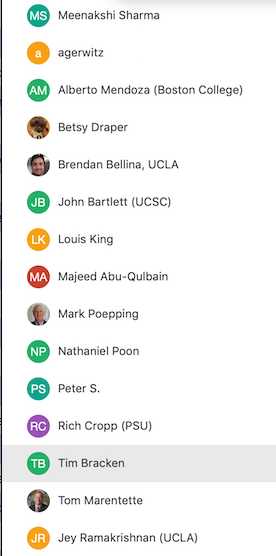Agenda
Presentation Link
New2EA Panel - Getting started with EA
Panelists:
Gregory Charestand Raoul P. Sevier, Enterprise Architects from Harvard University
Mark Poepping, Head IT Architect from Carnegie Mellon University
Peter Salvitti, Chief Technologist from Boston College
Betsy B. Draper, Associate Vice Provost (ITS) from Kansas State University
Maher Shinouda, Strategic Architect from University of Waterloo
What type of EA are you considering?
- Architect over a big system/solution architecture – for example an ERP program
- Head architect for an IT organization – how the technology pieces will fit together; might run an Architecture Review Board
- City planning metaphor – looking ahead, setting strategy, not limited to strategy, laying out where others will build something
- Business process outcome – primarily with working with business stakeholders
Peter Salvitti, Chief Technologist from Boston College:
Mix of all these. Boston College is implementing a Student Information System (offshoot of Kuali). Peter is architecting that system. Experience in City Planning and now shifting focus to business outcomes.
Gregory Charest and Raoul P. Sevier, Enterprise Architects from Harvard University:
Fit in the middle two categories (Head architect for an IT organization & City Planning). EA is under CTO’s office. Do a fair amount of city planning strategy, looking ahead. Would like to become more business outcome focused.
Betsy B. Draper, Associate Vice Provost (ITS) from Kansas State University
7 years of experience as Chief Architect with Federal customer. EA program was very mature there. The standards and documentation for Kansas State needed maturity when she came. They had an Interim CIO for 3 years and now a permanent CIO. Mandate from CIO was to get on every single committee working on institutional level initiative. They are more focused on business outcomes now.
Maher Shinouda, Strategic Architect from University of Waterloo
They are more of City Planning architects. Meher has a Strategic architect role. Supports the development and review of application portfolio to support strategic planning at central IT.
History of EA at Waterloo: Started in 2014 with an EA director, Business and Information architect and Strategic architect. Vision was to implement EA at the university level. It did not work at the beginning. In 2017, they reduced the focus and scope of EA into a central IT unit from where the EA practice can mature. Meher’s role (Strategic Architect) sits in PMO and Client Services office. Their focus is on Project, program management and Strategic Planning.
Mark Poepping, Head IT Architect from Carnegie Mellon University:
They have been doing it for a long time. Mark defined this job for the CIO long time ago. They are on to their 6th CIO. Earlier they had the buy-in from CIO but rest of the organization was still adjusting. Now the organization finally gets it.
What does EA mean to you?
Maher Shinouda, Strategic Architect from University of Waterloo
EA is fairly new at the University. They are in early stages in terms of maturity. There is no common understanding of EA. They are working on promoting EA across the organization. Came with a definition and mission to develop the EA practice.
Betsy B. Draper, Associate Vice Provost (ITS) from Kansas State University
They were using the term EA. Now ‘business outcomes’ term is used. They are about connecting the dots. Many people have different views/perspectives. This helps customers better understand what they do. Figure out what CIIO wants you to do. Typical talking points for EA were not cutting it. They are now focused on conversation around business outcomes e.g; what does it mean for a student to have successful interaction. They are connecting the dots.
Gregory Charest and Raoul P. Sevier, Enterprise Architects from Harvard University
They are all about alignment. Solution architects are owners of the technical problem whereas EA is focused on technology strategy across University that enables One Harvard , a technology strategy that is a reflection of a large university with schools that are independent and powerful. They try to differentiate what is an enterprise issue and what is an IT issue and how to deal with it.
Mark Poepping, Head IT Architect from Carnegie Mellon University:
EA at Carnegie Mellon meant Enterprise Applications earlier because of a misunderstanding of what EA means. They wear multiple hats. Last week got new CIO after 3 ½ years of interim CIO.
Mark agreed with Betsy Draper’s definition of what EA means (Kansas State) – connecting the dots. It is really about outcomes, starting by how to organize internally and what we are missing, architecting the enterprise, HR, processes, how we tie them together. EA is about a grand unifying vision of how all this fit together. They were often seen as competition not as a collaborator by IT Directors. With every new CIO you have to re-establish the trust and relationship.
Peter Salvitti, Chief Technologist from Boston College
They don’t use the word EA. Boston College is highly centralized but prior administration had an ivory tower approach and there was no collaboration and cooperation and lot of mistrust
Current CIO has mended lot of fences. We don’t call ourselves architects. EA is all about People, Culture, context and maturity. We are higher-ed which is very different from other industries. There is no pressure to deliver, and sometimes we keep moving the goal post. It is important to
understand the context and what we are trying to achieve. Architects deal with lot of technical debt but we talk about if the organization is ready to deal with the new change?
What is the motivation to start EA?
Peter Salvitti, Chief Technologist from Boston College
To understand people, process and technology. Not establishing something draconian. To reduce cost, increase agility and understanding and seeing what value are we bringing to the university.
Maher Shinouda, Strategic Architect from University of Waterloo
Main motivation was to align the business and IT at University level
Betsy B. Draper, Associate Vice Provost (ITS) from Kansas State University
When came to Kansas State, EA team complained that people don’t listen to us. In Federal Govt, I had a legislative mandate. I quickly recognized that EA didn’t have credibility with distributed IT group so started going business route. Eat your own dog food approach. We are going to work with business.
Mark Poepping, Head IT Architect from Carnegie Mellon University:
The foundational idea was balancing across stove pipes and balancing the approach from technologies that you should use. Context for the decision is helping the CIO. Brokering the stuff, not just local optimization
Where is your EA in the organization? Where was EA adding value?
Gregory Charest and Raoul P. Sevier, Enterprise Architects from Harvard University
University CIO took on the mission to rationalize the portfolios in the schools, rationalizing the SIS. Rationalizing, optimizing, alignment was the trend. Some of the early visibility came with architecture reviews, Mechanism was introduced to see if there could be synergies to have multiple organizations participate in the process, Architecture review boards.
Maher Shinouda, Strategic Architect from University of Waterloo
EA started as a group in central IT. It created a challenge. Rest of the IT felt that EA was taking over. Now EA is part of the PMO office.
Mark Poepping, Head IT Architect from Carnegie Mellon University
Always had CIO backing. Start from success and work your way forward. You can start small. They have a solution consulting practice for easy, small-medium sized problem. They do it as favors to make connection to the people they have to convince. Then you help them with pointing them to a solution. Then it’s a beginning of how and where it will fit.
Betsy B. Draper, Associate Vice Provost (ITS) from Kansas State University
Started the journey with a HR project. HR was doing project to reclassify job families Developed close relationship with HR during that project. Did a mini- business architecture approach with performing arts. HR people shared their example. This has spread like wildfire.
They have about 8 people. There is lot of need across the university
Peter Salvitti, Chief Technologist from Boston College
2011. No practice. Practices can be too draconian. Focus is to increase innovation, reduce costs, reduce risk. Deliver a sound holistic solution and simplify things.
Lessons Learned:
Maher Shinouda, Strategic Architect from University of Waterloo
Don’t start big and boil the ocean. Don’t make promises that you cannot deliver. Focus on 1-2 areas. Started with bottom-up approach. Avoid ivory tower approach, produce artifacts based on stakeholder needs.
Peter Salvitti, Chief Technologist from Boston College
Resist the urge to dive right in.
Mark Poepping, Head IT Architect from Carnegie Mellon University
Patience, Persistence, Planning, Listen. (Perspective)
Careful when people get locked into something. Eased people into a different idea. Get away from the urgency of the moment. Command and demand doesn’t do it.
Don’t mind taking the extra step.
Betsy B. Draper, Associate Vice Provost (ITS) from Kansas State University
Have your success stories in your pocket and ready to go, Pay close attention to what university administration is paying attention to.
Gregory Charest and Raoul P. Sevier, Enterprise Architects from Harvard University
Don’t be concerned if you have to re-invent yourself more than once. Find something that provides value. Cultivate relationships with folks
Peter Salvitti, Chief Technologist from Boston College
Stick to EA. I am fond of diving into details. Understand EA and stick with it.
Attendees
Brandon Ri...
1 (310) 206-21....
1 (734) 649-35...



